TC
Auto Added by WPeMatico
Auto Added by WPeMatico
Apple’s Craig Federighi announced that Apple was doubling down on performance with the upcoming release of iOS 12 at the WWDC event in San Jose, Calif. today.
What’s more, he said, the company would be making these changes to the full range of iOS devices going back to 2013. “And so for iOS 12, we are doubling down on performance from top to bottom making improvements to make your device faster and more responsive. And because we want these changes to be available the full range of our customers, iOS 12 will be available on all the same devices as iOS 11,” Federighi told the WWDC audience.
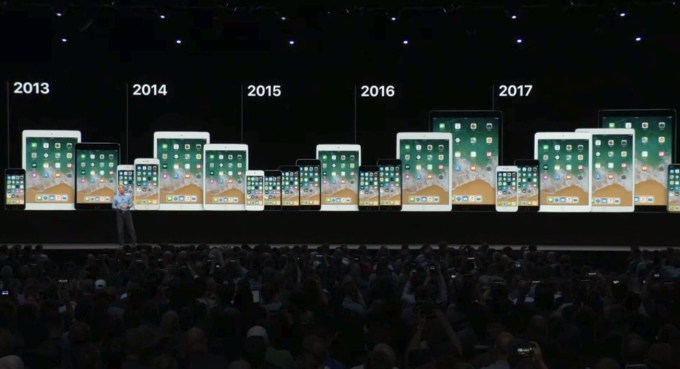
Perhaps because customers were unhappy to learn about the battery issues with older iOS devices Federighi stressed that Apple has focussed these performance increases on older devices, giving people with older iPhones, the maximum lift. Using the iPhone 6 as an example, he gave some figures about performance increase, stressing that it was still early days. (As an iPhone 6 user, I was listening carefully.)
 “Now on that device, iOS delivers a number of improvements. Across common operations you’ll see that apps launch up to 40% faster, the keyboard can come up to 50% faster and you can slide to take a photo at up to 70% faster,” he said.
“Now on that device, iOS delivers a number of improvements. Across common operations you’ll see that apps launch up to 40% faster, the keyboard can come up to 50% faster and you can slide to take a photo at up to 70% faster,” he said.
But he said, the biggest focus, and one all iPhone users can appreciate, is that they are working to optimize performance when it’s under load. As Federighi said that’s when you need performance the most and where iOS 12 really shines.
“We put iOS 12 through our stress tests and we saw in those conditions share sheet coming up twice as fast, and apps launching twice as fast. These are big, big improvements,” he stressed.
Lastly, Apple also optimized iOS 12 at the chip level working with the chip team to optimize performance, while taking battery life into account. If you keep the power pedal to the metal for too long, you suck battery, but Apple is trying to find that perfect balance of power and battery life in iOS 12.
“CPUs traditionally respond to an increased demand for performance by slowly ramping up their clock speed. Well, now in iOS 12, we’re much smarter. When we detect that you need a performance lift when you’re scrolling and launching an app, we ramped up processor performance instantly to its highest state delivering high performance and a ramp it down just as fast to preserve battery life,” he said.
All of this will be available when iOS 12 is released later this year.
Powered by WPeMatico
Do you have an application that needs a lot of memory? Maybe as much as 12 terabytes of memory? Well, you’re in luck because Microsoft Azure will soon offer virtual machines with just that much RAM, based on Intel’s Xeon Scalable servers.
The company made this announcement in concert with the launch of a number of other virtual machine (VM) types that are specifically geared toward running high-memory workloads — and the standard use cases for this is running the SAP Hana in-memory database service.
So in addition to this massive new 12 TB VM, Microsoft is also launching a new 192 GB machine that extends the lower end of Hana-optimized machines on Azure, as well as a number other Hana options that scale across multiple VMs and can offer combined memory sizes of up to 18 TB.
Another new feature of Azure launching today is Standards SSDs. These will offer Azure users a new option for running entry-level production workloads that require consistent disk performance and throughput without the full price of what are now called “premium SSD.” The Standard SSDs won’t offer the same kind of performance, though, but Microsoft promises that developers will still get improved latency, reliability and scalability as compared to standard hard disks in its cloud.
Powered by WPeMatico
PlayVS, the startup building esports infrastructure at the high school level, has today announced the close of a $15 million Series A funding round. The financing was led by New Enterprise Associates, with participation from existing investor Science, as well as CrossCut Ventures, Coatue Management, Cross Culture Ventures, the San Francisco 49ers, Nas, Dollar Shave Club founder Michael Dubin, Twitch cofounder Kevin Lin, and others.
PlayVS first publicly launched out of the LA-based Science startup studio in April. The company partnered with the NFHS, the equivalent of the NCAA for high school-level sports, to build out leagues, rules and more around high school esports.
Most high school sports are governed by the NFHS, which writes the rules, hires referees, schedules seasons and determines the format of playoffs and state championships. That same infrastructure might carry over from one high school sport to another, but esports represents a new challenge for the NFHS.
PlayVS brings to market a platform that schedules games, helps schools hold try-outs and form teams, and pulls in stats real-time from games thanks to partnerships with game publishers.
In October, PlayVS will launch its inaugural season, bringing organized esports to more than 18 states and approximately 5 million students across 5,000 high schools.
As esports continue to grow, colleges and professional organizations have already started investing in scholarship programs and pro teams respectively. But whereas other high-level teams look at high school athletes for recruiting, the same infrastructure has not yet been put into place for esports.
PlayVS wants to change that. The new round of funding will go towards expanding the product and the team to eventually put PlayVS in every high school across the country. The company has yet to announce which schools will participate and which games will be available during the first season, but PlayVS has confirmed that the games will be PC-based and will come from the Multiplayer Online Battle Arena, Fighting and Sports genres.
Powered by WPeMatico
Back in 2013, Yelp was a 9-year old company built on a set of internal systems. It was coming to the realization that running its own data centers might not be the most efficient way to run a business that was continuing to scale rapidly. At the same time, the company understood that the tech world had changed dramatically from 2004 when it launched and it needed to transform the underlying technology to a more modern approach.
That’s a lot to take on in one bite, but it wasn’t something that happened willy-nilly or overnight says Jason Fennell, SVP of engineering at Yelp . The vast majority of the company’s data was being processed in a massive Python repository that was getting bigger all the time. The conversation about shifting to a microservices architecture began in 2012.
The company was also running the massive Yelp application inside its own datacenters, and as it grew it was increasingly becoming limited by long lead times required to procure and get new hardware online. It saw this was an unsustainable situation over the long-term and began a process of transforming from running a huge monolithic application on-premises to one built on microservices running in the cloud. It was a quite a journey.
Fennell described the classic scenario of a company that could benefit from a shift to the cloud. Yelp had a small operations team dedicated to setting up new machines. When engineering anticipated a new resource requirement, they had to give the operations team sufficient lead time to order new servers and get them up and running, certainly not the most efficient way to deal with a resource problem, and one that would have been easily solved by the cloud.

“We kept running into a bottleneck, I was running a chunk of the search team [at the time] and I had to project capacity out to 6-9 months. Then it would take a few months to order machines and another few months to set them up,” Fennell explained. He emphasized that the team charged with getting these machines going was working hard, but there were too few people and too many demands and something had to give.
“We were on this cusp. We could have scaled up that team dramatically and gotten [better] at building data centers and buying servers and doing that really fast, but we were hearing a lot of AWS and the advantages there,” Fennell explained.
They looked at the cloud market landscape in 2013 and AWS was the clear leader technologically. That meant moving some part of their operations to EC2. Unfortunately, that exposed a new problem: how to manage this new infrastructure in the cloud. This was before the notion of cloud-native computing even existed. There was no Kubernetes. Sure, Google was operating in a cloud-native fashion in-house, but it was not really an option for most companies without a huge team of engineers.
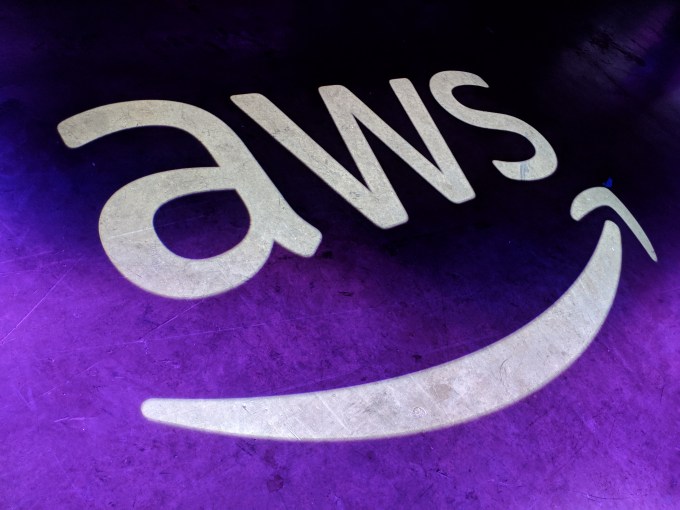
Yelp needed to explore new ways of managing operations in a hybrid cloud environment where some of the applications and data lived in the cloud and some lived in their data center. It was not an easy problem to solve in 2013 and Yelp had to be creative to make it work.
That meant remaining with one foot in the public cloud and the other in a private data center. One tool that helped ease the transition was AWS Direct Connect, which was released the prior year and enabled Yelp to directly connect from their data center to the cloud.
About this time, as they were figuring out how AWS works, another revolutionary technological change was occurring when Docker emerged and began mainstreaming the notion of containerization. “That’s another thing that’s been revolutionary. We could suddenly decouple the context of the running program from the machine it’s running on. Docker gives you this container, and is much lighter weight than virtualization and running full operating systems on a machine,” Fennell explained.
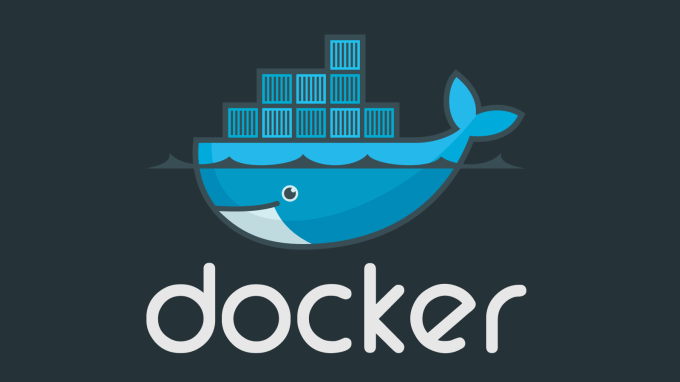
Another thing that was happening was the emergence of the open source data center operating system called Mesos, which offered a way to treat the data center as a single pool of resources. They could apply this notion to wherever the data and applications lived. Mesos also offered a container orchestration tool called Marathon in the days before Kubernetes emerged as a popular way of dealing with this same issue.
“We liked Mesos as a resource allocation framework. It abstracted away the fleet of machines. Mesos abstracts many machines and controls programs across them. Marathon holds guarantees about what containers are running where. We could stitch it all together into this clear opinionated interface,” he said.
While all this was happening, Yelp began exploring how to move to the cloud and use a Platform as a Service approach to the software layer. The problem was at the time they started, there wasn’t really any viable way to do this. In the buy versus build decision making that goes on in large transformations like this one, they felt they had little choice but to build that platform layer themselves.
In late 2013 they began to pull together the idea of building this platform on top of Mesos and Docker, giving it the name PaaSTA, an internal joke that stood for Platform as a Service, Totally Awesome. It became simply known as Pasta.

Photo: David Silverman/Getty Images
The project had the ambitious goal of making their infrastructure work as a single fabric, in a cloud-native fashion before most anyone outside of Google was using that term. Pasta developed slowly with the first developer piece coming online in August 2014 and the first production service later that year in December. The company actually open sourced the technology the following year.
“Pasta gave us the interface between the applications and development teams. Operations had to make sure Pasta is up and running, while Development was responsible for implementing containers that implemented the interface,” Fennell said.
While Yelp was busy building these internal systems, AWS wasn’t sitting still. It was also improving its offerings with new instance types, new functionality and better APIs and tooling. Fennell reports this helped immensely as Yelp began a more complete move to the cloud.
He says there were a couple of tipping points as they moved more and more of the application to AWS — including eventually, the master database. This all happened in more recent years as they understood better how to use Pasta to control the processes wherever they lived. What’s more, he said that adoption of other AWS services was now possible due to tighter integration between the in-house data centers and AWS.

Photo: erhui1979/Getty Images
The first tipping point came around 2016 as all new services were configured for the cloud. He said they began to get much better at managing applications and infrastructure in AWS and their thinking shifted from how to migrate to AWS to how to operate and manage it.
Perhaps the biggest step in this years-long transformation came last summer when Yelp moved its master database from its own data center to AWS. “This was the last thing we needed to move over. Otherwise it’s clean up. As of 2018, we are serving zero production traffic through physical data centers,” he said. While they still have two data centers, they are getting to the point, they have the minimum hardware required to run the network backbone.
Fennell said they went from two weeks to a month to get a service up and running before this was all in place to just a couple of minutes. He says any loss of control by moving to the cloud has been easily offset by the convenience of using cloud infrastructure. “We get to focus on the things where we add value,” he said — and that’s the goal of every company.
Powered by WPeMatico
America’s mayors have spent the past nine months tripping over each other to curry favor with Amazon.com in its high-profile search for a second headquarters.
More quietly, however, a similar story has been playing out in startup-land. Many of the most valuable venture-backed companies are venturing outside their high-cost headquarters and setting up secondary hubs in smaller cities.
Where are they going? Nashville is pretty popular. So is Phoenix. Portland and Raleigh also are seeing some jobs. A number of companies also have a high number of remote offerings, seeking candidates with coveted skills who don’t want to relocate.
Those are some of the findings from a Crunchbase News analysis of the geographic hiring practices of U.S. unicorns. Since most of these companies are based in high-cost locations, like the San Francisco Bay Area, Boston and New York, we were looking to see if there is a pattern of setting up offices in smaller, cheaper cities. (For more on survey technique, see Methodology section below.)
Here is a look at some of the hotspots.
One surprise finding was the prominence of Nashville among secondary locations for startup offices.
We found at least four unicorns scaling up Nashville offices, plus another three with growing operations in or around other Tennessee cities. Here are some of the Tennessee-loving startups:
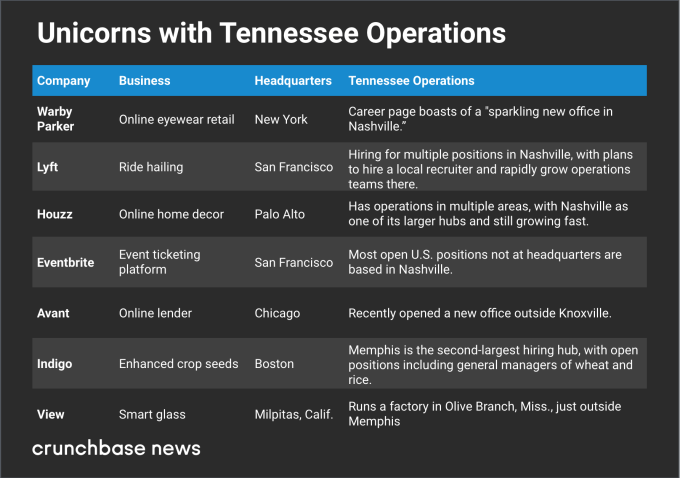
When we referred to Nashville’s popularity with unicorns as surprising, that was largely because the city isn’t known as a major hub for tech startups or venture funding. That said, it has a lot of attributes that make for a practical and desirable location for a secondary office.
Nashville’s attractions include high quality of life ratings, a growing population and economy, mild climate and lots of live music. Home prices and overall cost of living are also still far below Silicon Valley and New York, even though the Nashville real estate market has been on a tear for the past several years. An added perk for workers: Tennessee has no income tax on wages.
Phoenix is another popular pick for startup offices, particularly West Coast companies seeking a lower-cost hub for customer service and other operations that require a large staff.
In the chart below, we look at five unicorns with significant staffing in the desert city:
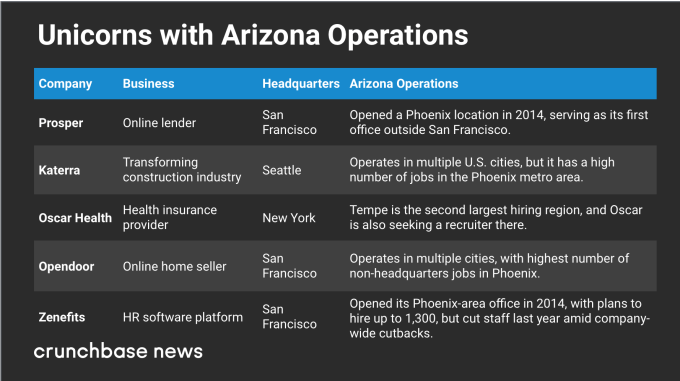
Affordability, ease of expansion and a large employable population look like big factors in Phoenix’s appeal. Homes and overall cost of living are a lot cheaper than the big coastal cities. And there’s plenty of room to sprawl.
One article about a new office opening also cited low job turnover rates as an attractive Phoenix-area attribute, which is an interesting notion. Startup hubs like San Francisco and New York see a lot of job-hopping, particularly for people with in-demand skill sets. Scaling companies may be looking for people who measure their job tenure in years rather than months.
Nashville and Phoenix aren’t the only hotspots for unicorns setting up secondary offices. Many other cities are also seeing some scaling startup activity.
Let’s start with North Carolina. The Research Triangle region is known for having a lot of STEM grads, so it makes sense that deep tech companies headquartered elsewhere might still want a local base. One such company is cybersecurity unicorn Tanium, which has a lot of technical job openings in the area. Another is Docker, developer of software containerization technology, which has open positions in Raleigh.
The Orlando metro area stood out mostly due to Robinhood, the zero-fee stock and crypto trading platform that recently hit the $5 billion valuation mark. The Silicon Valley-based company has a significant number of open positions in Lake Mary, an Orlando suburb, including HR and compliance jobs.
Portland, meanwhile, just drew another crypto-loving unicorn, digital currency transaction platform Coinbase. The San Francisco-based company recently opened an office in the Oregon city and is currently in hiring mode.
But you don’t have to be anywhere in particular to score jobs at many fast-growing startups. A lot of unicorns have a high number of remote positions, including specialized technical roles that may be hard to fill locally.
GitHub, which makes tools developers can use to collaborate remotely on projects, does a particularly good job of practicing what it codes. A notable number of engineering jobs open at the San Francisco-based company are available to remote workers, and other departments also have some openings for telecommuters.
Others with a smattering of remote openings include Silicon Valley-based cybersecurity provider CrowdStrike, enterprise software developer Apttus and also Docker.
Of course, not every unicorn is opening large secondary offices. Many prefer to keep staff closer to home base, seeking to lure employees with chic workplaces and lavish perks. Other companies find that when they do expand, it makes strategic sense to go to another high-cost location.
Still, the secondary hub phenomenon may offer a partial antidote to complaints that a few regions are hogging too much of the venture capital pie. While unicorns still overwhelmingly headquarter in a handful of cities, at least they’re spreading their wings and providing more jobs in other places, too.
For this analysis, we were looking at U.S. unicorns with secondary offices in other North American cities. We began with a list of 125 U.S.-based companies and looked at open positions advertised on their websites, focusing on job location.
We excluded job offerings related to representing a local market. For instance, a San Francisco company seeking a sales rep in Chicago to sell to Chicago customers doesn’t count. Instead, we looked for openings for team members handling core operations, including engineering, finances and company-wide customer support. We also excluded secondary offices outside of North America.
Additionally, we were looking principally for companies expanding into lower-cost areas. In many cases, we did see companies strategically adding staff in other high-cost locations, such as New York and Silicon Valley.
A final note pertains to Austin, Texas. We did see several unicorns based elsewhere with job openings in Austin. However, we did not include the city in the sections above because Austin, although a lower-cost location than Silicon Valley, may also be characterized as a large, mature technology and startup hub in its own right.
Powered by WPeMatico
Instagram users were missing 70 percent of all posts and 50 percent of their friends’ posts before the app ditched the reverse chronological feed for an algorithm in July 2016. Despite backlash about confusing ordering, Instagram now says relevancy sorting has led to its 800 million-plus users seeing 90 percent of their friends’ posts and spending more time on the app.
Yet Instagram has never explained exactly how the algorithm chooses what to show you until today. The Facebook-owned company assembled a group of reporters at its under-construction new San Francisco office to take the lid off the Instagram feed ranking algorithm.

Instagram product lead Julian Gutman explains the algorithm
Instagram relies on machine learning based on your past behavior to create a unique feed for everyone. Even if you follow the exact same accounts as someone else, you’ll get a personalized feed based on how you interact with those accounts.
Three main factors determine what you see in your Instagram feed:

Beyond those core factors, three additional signals that influence rankings are:
Instagram’s team also responded to many of the most common questions and conspiracy theories about how its feed works. TechCrunch can’t verify the accuracy of these claims, but this is what Instagram’s team told us:
Today’s Instagram whiteboard session with reporters, its first, should go a long way to clearing up misunderstandings about how it works. When people feel confident that their posts will reach their favorite people, that they can reliably build a public audience, and that they’ll always see great content, they’ll open the app more often.
Yet on the horizon looms a problem similar to what Facebook’s algorithm experienced around 2015: competition reduces reach. As more users and businesses join Instagram and post more often, but feed browsing time stays stable per user, the average post will get drowned out and receive fewer views. People will inevitably complain that Instagram is trying to force them to buy ads, but it’s a natural and inevitable consequence of increasingly popular algorithmic feeds.
The more Instagram can disarm that problem by pushing excess content creation to Stories and educating users about how the feed operates, the less they’ll complain. Facebook is already uncool, so Instagram must stay in our good graces.
Powered by WPeMatico
Apple is fixing one of the worst parts of the concert experience: waiting in line for a beer while you miss your favorite song. Last week’s BottleRock music festival near San Francisco was the first to try a new “order ahead with Apple Pay” feature that Apple hopes to bring to more events. You just open the festival’s app, select the closest concession stand, choose your drinks, Apple Pay with your face or fingerprint and pick up the beverages at a dedicated window with no queue.
Check out our demo video below.
BottleRock’s upscale wine and oldies music fest, 100 miles from the tech giant’s headquarters, has become a testbed for Apple Pay. Last year, every concession stand got equipped with the Square’s Apple Pay-ready point of sale system and special fast lanes for customers who used it instead of cash or credit card. Thirty percent of all transactions at BottleRock were made with Apple Pay, according to an Apple spokesperson, proving people wanted a faster way to get back to the show.
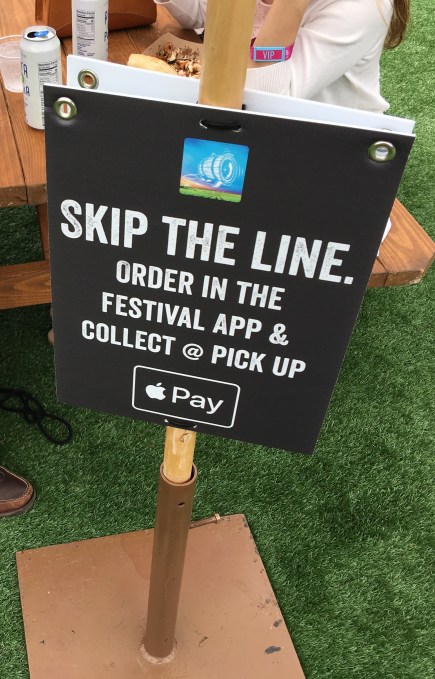
With order ahead, your drinks are ready for pick up so you don’t even have to break your dance stride. Having gone to 14 Coachellas, I’d learned to forego booze rather than risk losing my friends or a chance to hear that hit single while stewing in the beer garden lines. But Apple Pay powered the best concert commerce experience I’ve had yet. I’m sure I’m not the only one who knocked back a few more drinks last weekend because it was so convenient.
That’s why I foresee music festivals jumping at the chance to integrate into their apps order ahead with Apple Pay. They and their vendors will see more sales, while attendees see more music. Meanwhile, it’s a smart way for Apple to reach a juicy demographic. Apple Pay is especially helpful when you’re in a rush, but festival goers will return home more likely to use it day-to-day.
Often times, music festival tech, like friend-finding apps and location-based alerts, can interrupt the moment. Apple Pay succeeds here by fading away, keeping you in harmony with the present.
Powered by WPeMatico
In a delightful bit of irony BitBay, a Central European exchange, has shut down operations in Poland even as it received an invitation by the Polish government to participate in a national blockchain working group. The news, which appeared in a Tweet, states that the group will assess regulations for cryptocurrencies, blockchain, and ICOs.
“Our exchange has received an invitation from the PFSA to participate in the Blockchain Working Group.  As we have recently said, we do not want to abandon crypto activity in the Polish community,” wrote BitBay.
As we have recently said, we do not want to abandon crypto activity in the Polish community,” wrote BitBay.
Nasza giełda otrzymała zaproszenie z KNF do udziału w pracach Grupy roboczej ds. Blockchain.
Jak zapewnialiśmy ostatnio, nie porzucamy aktywności na rzecz polskiej społeczności krypto. @k_wysota @Bitcoin_org_pl @comparic @bithub @Marta_Bellon @MichWasowski @_ZajacPiotr @macdac pic.twitter.com/bxhu4EGWvJ
— BitBay (@BitBayPolska) May 30, 2018
Poland has had an odd relationship with Bitcoin. First, some of the central banks funded a YouTube propaganda video that showed a person losing plenty of cash in crypto. Further, the community is fighting back but releasing counter-propaganda to the central bank’s policies.
After being shut out by Polish banks, BitBay moved its headquarters to Malta and stopped serving Polish customers.
Photo by freestocks.org on Unsplash
Powered by WPeMatico
Walmart’s tech incubator is out with its first experiment. The incubator, known as Store No. 8, just launched Jetblack, a concierge-style service for requesting stuff and getting it really quickly. During its pilot period, the project was known as Code Eight.
To shop with Jetblack, first you need an invite. Right now the service is limited to some customers in Manhattan and Brooklyn who are part of an eight-month pilot program restricted to buildings with a doorman, though that will soon expand and a waitlist is available now. The service is $50 a month — considerably less than some adjacent competitors, while considerably more than Amazon Prime — and promises same-day delivery.
While concierge services like Hello Alfred position themselves as high-end options for people wishing to live more serene lives, Jetblack is focusing on “time-strapped urban parents” seeking “more efficient ways to shop for themselves and their families.” To request something, Jetblack members send a text message and will receive product recommendations sent back in text. Those recommendations are culled from Walmart and Jet.com but also from specialty retailers locally.
That means any product request is fair game and “sourcing a specific beauty cream from a member’s favorite local boutique, curating custom Easter baskets and delivering them once the kids are asleep and rushing beach essentials to a family on vacation” are all within the realm of Jetblack fulfillments.
“Consumers are looking for more efficient ways to shop for themselves and their families without having to compromise on product quality,” said Jetblack co-founder and CEO Jenny Fleiss, formerly of Rent the Runway.
“With Jetblack, we have created an entirely new concept that enables consumers to get exactly what they need through the convenience of text messaging and the freedom of a nearly unlimited product catalogue.”
It’ll be interesting to see if these kind of personal shopping services can differentiate themselves in markets already well-acquainted with same-day shipping. While what makes Jetblack’s proposition unique isn’t that clear, it’s worth noting thanks to its roots in the biggest brick-and-mortar retailer around.
Powered by WPeMatico
Machine learning is one of those buzzwords that nearly every tech company likes to throw around nowadays — but according to Lukas Biewald, it represents a genuinely new approach to programming.
“Software has eaten a lot of the world, and machine learning is eating software,” Biewald said.
In his view, there are “fundamental” differences between the two approaches: “One important difference is if all you have is the code you used to train the program, you don’t really know what happened … If I had all the code that was used to train a self-driving car algorithm but I don’t have the data, I don’t know what went down.”
Along with Chris Van Pelt, Biewald previously founded CrowdFlower (now known as Figure Eight), which launched nearly a decade ago at the TechCrunch 50 conference, and which has created tools for training artificial intelligence.
Biewald (whom I’ve known since college) and Van Pelt, plus former Google engineer Shawn Lewis, have now started a new company called Weights & Biases to build new tools for machine learning developers. They’ve also raised $5 million in Series A funding from Trinity Ventures and Bloomberg Beta.
“Artificial Intelligence has so much potential, but few companies are implementing it yet because the development process is too complicated for all but a small number of highly trained engineers,” said Trinity’s Dan Scholnick, who’s joining the startup’s board of directors. (Scholnick previously backed CrowdFlower.) “W&B aims to dramatically streamline the machine learning software development process so that AI benefits can be unlocked across industries and no longer restricted to the few firms able to hire extremely skilled and extraordinarily expensive AI developers today.”

The eventual goal is to create a whole suite of development tools, but Weights & Biases’ first product records and visualizes the process of training a machine learning algorithm. Biewald explained that this makes it possible for developers to go back and see what they were doing, say, a month ago and to share that information with teammates. And it’s already being used by the nonprofit research company OpenAI.
Biewald added that when he talked to his friends in the field about their biggest problems, this was the first thing that came up. That’s how he hopes to approach future products as well — working with developers to figure out what they really need.
“I don’t want to help with the hype,” he said. “I want to help with the real problems that really get in the way … to make this stuff actually work.”
Biewald also offered more details about his vision for the company in a blog post:
You can’t paint well with a crappy paintbrush, you can’t write code well in a crappy IDE, and you can’t build and deploy great deep learning models with the tools we have now. I can’t think of any more important goal than changing that.
Powered by WPeMatico